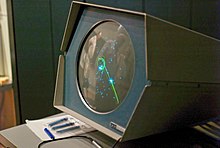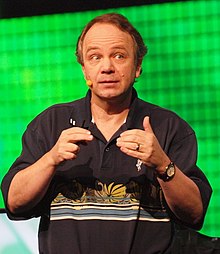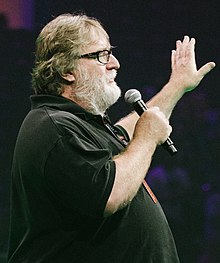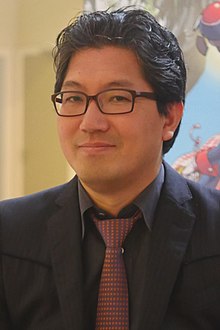Portal:Video games
Portal maintenance status: (January 2025)
|
The Video Games Portal

A video game, sometimes further qualified as a computer game, is an electronic game that involves interaction with a user interface or input device (such as a joystick, controller, keyboard, or motion sensing device) to generate visual feedback from a display device, most commonly shown in a video format on a television set, computer monitor, flat-panel display or touchscreen on handheld devices, or a virtual reality headset. Most modern video games are audiovisual, with audio complement delivered through speakers or headphones, and sometimes also with other types of sensory feedback (e.g., haptic technology that provides tactile sensations). Some video games also allow microphone and webcam inputs for in-game chatting and livestreaming.
Video games are typically categorized according to their hardware platform, which traditionally includes arcade video games, console games, and computer games (which includes LAN games, online games, and browser games). More recently, the video game industry has expanded onto mobile gaming through mobile devices (such as smartphones and tablet computers), virtual and augmented reality systems, and remote cloud gaming. Video games are also classified into a wide range of genres based on their style of gameplay and target audience. (Full article...)
Featured articles – load new batch
-
Image 1Alleyway is a 1989 video game developed by Nintendo and Intelligent Systems and published by Nintendo as a global launch title for the Game Boy. It is a Breakout clone and one of the first four games developed and released for the system. The game was released first in Japan in 1989, in North America later that year, and in Europe in 1990. It was later re-released for the Nintendo 3DS Virtual Console in June 2011, and on the Nintendo Switch Online service in May 2024.
The name Alleyway references the in-game gateway that the player's spaceship (represented as a paddle) must pass through. While Alleyway is a portable clone of Breakout, it adds several features, including alternating stages, bonus rounds, and hazards for the player at later levels. While the game's original box art featured an unidentifiable protagonist, later international releases of the game replaced the character with Mario. Alleyway was released with limited advertising, receiving moderate to low scores from reviewers who compared it to games like Arkanoid. (Full article...) -
Image 21080° Snowboarding is a snowboarding video game developed and published by Nintendo for the Nintendo 64 in 1998. In the game, players control one of five snowboarders from a third-person perspective, using a combination of buttons to jump and perform tricks across eight levels.
1080° was announced in November 1997 and developed over nine months. It received critical acclaim and won an Interactive Achievement Award from the Academy of Interactive Arts & Sciences. The game sold over two million units. A sequel, 1080° Avalanche, was released for the GameCube in November 2003. The game was re-released for the Wii in 2008 and for the Wii U Virtual Console in 2016. It was also re-released on the Nintendo Switch Online + Expansion Pack in 2023. (Full article...) -
Image 3

The Magnavox Odyssey is the first commercial home video game console. The hardware was designed by a small team led by Ralph H. Baer at Sanders Associates, while Magnavox completed development and released it in the United States in September 1972 and overseas the following year. The Odyssey consists of a white, black, and brown box that connects to a television set, and two rectangular controllers attached by wires. It is capable of displaying three square dots and one line of varying height on the screen in monochrome black and white, with differing behavior for the dots depending on the game played. Players place plastic overlays on the screen to display additional visual elements for each game, and one or two players for each game control their dots with the knobs and buttons on the controller by the rules given for the game. The console cannot generate audio or track scores. The Odyssey console came packaged with dice, paper money, and other board game paraphernalia to accompany the games, while a peripheral controller—the first video game light gun—was sold separately.
The idea for a video game console was conceived by Baer in August 1966. Over the next three years he, along with Bill Harrison and Bill Rusch, created seven successive prototype consoles. The seventh, known as the Brown Box, was shown to several manufacturers before Magnavox agreed to produce it in January 1971. After releasing the console through their dealerships, Magnavox sold 69,000 units in its first calendar year and 350,000 by the time the console was discontinued in 1975. The console spawned the Odyssey series of dedicated consoles as well as the 1978 Magnavox Odyssey 2. One of the 28 games made for the system, a ping-pong game, was an inspiration for Atari's successful 1972 Pong arcade game, in turn driving sales of the Odyssey. Patents by Baer and the other developers for the system and the games, including what was termed by a judge as "the pioneering patent of the video game art", formed the basis of a series of lawsuits spanning 20 years, earning Sanders and Magnavox over US$100 million. The release of the Odyssey marked the beginning of the first generation of video game consoles and was an early part of the rise of the commercial video game industry. (Full article...) -
Image 4The Simpsons Game is a 2007 platform game based on the animated television series The Simpsons made for the Nintendo DS, Wii, Xbox 360, PlayStation 2, PlayStation 3 and PlayStation Portable. The game was published and distributed by Electronic Arts. It was released in North America in October 2007 and worldwide in November 2007, a few months after The Simpsons Movie. It features an original storyline, not related to the movie, written by Simpsons writers Tim Long and Matt Warburton. In the self-referential plot, the family discovers that they are forced to participate in another The Simpsons video game. Similar to the show, the game pokes fun at popular culture, many other video games, and Electronic Arts, its publisher.
The game follows the five Simpsons family members—Homer, Marge, Bart, Lisa and Maggie—who learn they are part of a video game and are given superpowers to resolve several situations. Eventually, they must save their 8-bit predecessors from Will Wright, and the creator of their video game character selves, Matt Groening. The Simpsons family travels to four scenarios in parodies of other games to collect key cards used to infiltrate their creator's mansion and ultimately to save their predecessors from destruction to reverse their generations old ban on video games.
The game was met with mixed reception from video game critics. They praised its visuals, writing, and faithfulness to the original material, while they criticized its short length and poor camera system, which did not always function properly. The Simpsons Game received the Best Game Based on a Movie or TV Show award at the 2007 Spike Video Game Awards and was nominated for Best Video Game Writing at the 2007 Writers Guild of America Awards. As of January 31, 2008, four million copies of the game have been sold worldwide. (Full article...) -
Image 5Kingdom Hearts: Chain of Memories is an action role-playing video game that was developed by Square Enix and Jupiter, and published by Square Enix in collaboration with Disney Interactive in 2004 for the Game Boy Advance (GBA). The game, which is an intermediary between the two larger-scale PlayStation 2 games in the Kingdom Hearts series, was one of the first GBA games to incorporate full motion video (FMV).
Kingdom Hearts: Chain of Memories is the second game in the Kingdom Hearts series. It is a direct sequel to Kingdom Hearts whose ending is set about a year before the events of Kingdom Hearts II. Kingdom Hearts: Chain of Memories follows Sora and his friends as they explore the mysterious Castle Oblivion while battling the sinister Organization XIII, a new group of antagonists in the series. The game introduces new characters and plot lines that further expand the Kingdom Hearts universe and set up the premise of Kingdom Hearts II. The game uses a new card-based battle system rather than its predecessor's real-time combat system.
Though it was not as successful as the other Kingdom Hearts games, Kingdom Hearts: Chain of Memories received positive reviews and sold well. It was praised for its story, graphics, and full-motion videos (FMV) but its card-based battle system was criticized. When it debuted in Japan, the game sold over 100,000 units in 48 hours. Kingdom Hearts: Chain of Memories was remade for the PlayStation 2 as Kingdom Hearts Re:Chain of Memories, which was packaged with Kingdom Hearts II Final Mix and released in Japan in March 2007. The remake was released in North America on December 2, 2008, and was remastered in high definition (HD) and included in the Kingdom Hearts HD 1.5 Remix collection, which was released in 2013 for the PlayStation 3 (PS3), and later for PlayStation 4 (PS4), Xbox One, and personal computer (PC). (Full article...) -
Image 6
Spacewar! is a space combat video game developed in 1962 by Steve Russell in collaboration with Martin Graetz, Wayne Wiitanen, Bob Saunders, Steve Piner, and others. It was written for the newly installed DEC PDP-1 minicomputer at the Massachusetts Institute of Technology. After its initial creation, Spacewar! was expanded further by other students and employees of universities in the area, including Dan Edwards and Peter Samson. It was also spread to many of the few dozen installations of the PDP-1 computer, making Spacewar! the first known video game to be played at multiple computer installations.
The game features two spaceships, "the needle" and "the wedge", engaged in a dogfight while maneuvering in the gravity well of a star. Both ships are controlled by human players. Each ship has limited weaponry and fuel for maneuvering, and the ships remain in motion even when the player is not accelerating. Flying near the star to provide a gravity assist was a common tactic. Ships are destroyed when they collide with a torpedo, the star, or each other. At any time, the player can engage a hyperspace feature to move to a new and random location on the screen, though in some versions each use has an increasing chance of destroying the ship instead. The game was initially controlled with switches on the PDP-1, though Bob Saunders built an early gamepad to reduce the difficulty and awkwardness of controlling the game.
Spacewar! is one of the most important and influential games in the early history of video games. It was extremely popular in the small programming community in the 1960s and the public domain code was widely ported to and recreated on other computer systems at the time, especially after computer systems with monitors became more widespread towards the end of the decade. It has also been recreated in more modern programming languages for PDP-1 emulators. It directly inspired many other video games, such as the first commercial arcade video games, Galaxy Game and Computer Space (both from 1971), and later games such as Asteroids (1979). In 2007, Spacewar! was named to a list of the ten most important video games in history, which formed the start of the game canon at the Library of Congress, and in 2018 it was inducted into the World Video Game Hall of Fame by The Strong and the International Center for the History of Electronic Games. (Full article...) -
Image 7God of War: Chains of Olympus is an action-adventure hack and slash video game developed by Ready at Dawn, and published by Sony Computer Entertainment (SCE). It was first released for the PlayStation Portable (PSP) handheld console on March 4, 2008. The game is the fourth installment in the God of War series, the second chronologically, and a prequel to the original God of War. It is loosely based on Greek mythology and set in ancient Greece, with vengeance as its central motif. The player controls Kratos, a Spartan warrior who serves the Olympian gods. Kratos is guided by the goddess Athena, who instructs him to find the Sun God Helios, as the Dream God Morpheus has caused many of the gods to slumber in Helios' absence. With the power of the Sun and the aid of the Titan Atlas, Morpheus and the Queen of the Underworld Persephone intend to destroy the Pillar of the World and in turn Olympus.
The gameplay is similar to the previous installments, with a focus on combo-based combat, achieved through the player's main weapon—the Blades of Chaos—and secondary weapons acquired throughout the game. It features quick time events that require the player to complete game controller actions in a timed sequence to defeat stronger enemies and bosses. The player can use up to three magical attacks as alternative combat options. The game also features puzzles and platforming elements. The series' control scheme was reconfigured to compensate for the smaller number of buttons on the PSP compared to the PlayStation 2's controller; Ready at Dawn's solutions for the controls were praised by critics.
Chains of Olympus was acclaimed by critics, becoming the highest-rated PSP title on Metacritic and GameRankings. The game's graphics were particularly praised, with 1UP declaring the game was "a technical showpiece for Sony, and arguably the best-looking game on the system." It won several awards, including "Best PSP Action Game", "Best Graphics Technology", and "Best Use of Sound". As of June 2012, the game has sold 3.2 million copies worldwide, making it the seventh best-selling PlayStation Portable game of all time. Together with 2010's God of War: Ghost of Sparta, Chains of Olympus was remastered and released on September 13, 2011, as part of the God of War: Origins Collection for the PlayStation 3. The remastered version was included in the God of War Saga released on August 28, 2012, also for PlayStation 3. (Full article...) -
Image 8Doom is a 2016 first-person shooter video game developed by id Software and published by Bethesda Softworks. The game is the first major installment in the Doom series since 2004's Doom 3 and is a reboot of the franchise. It was released for PlayStation 4, Windows, and Xbox One in May 2016. A port for Nintendo Switch was co-developed with Panic Button and released in November 2017, and a version for Google Stadia was released in August 2020. Players take the role of an unnamed space marine, known as the "Doom Slayer", as he battles demonic forces within an energy-mining facility on Mars and in Hell.
Doom was announced as Doom 4 in 2008, and that version underwent an extensive development cycle with different builds and designs before the game was restarted in 2011 and re-revealed as simply Doom in 2014. It was tested by customers who pre-ordered the 2014 MachineGames game Wolfenstein: The New Order and the general public. Mick Gordon composed the music, with contributions by Richard Devine. The game also has an online multiplayer component and a level editor known as "SnapMap", co-developed with Certain Affinity and Escalation Studios respectively.
Doom was well received by critics and players. The single-player campaign, graphics, soundtrack, and gameplay received considerable praise, whereas the multiplayer mode drew significant criticism. It was the second best-selling video game in North America and the United Kingdom in the week of its release and sold over 500,000 copies for PCs by the end of May 2016. A sequel, Doom Eternal, was released in March 2020. A prequel, Doom: The Dark Ages, is set to be released in 2025. (Full article...) -
Image 9The development of The Elder Scrolls IV: Oblivion began in 2002, immediately after its predecessor, The Elder Scrolls III: Morrowind, was published. Rumors of a sequel to Morrowind started circulating in June 2004; the sequel's title was identified on September 10, 2004, the date of its official announcement. Oblivion was developed by Bethesda Game Studios, and the initial Xbox 360 and personal computer (PC) releases were co-published by Bethesda Softworks and Take-Two Interactive's subsidiary, 2K Games. According to interviews with Bethesda staff, the publisher-developer relationship—one of the few independent relations in the industry—worked well, and Bethesda was not subject to excessive corporate guidance. Initially scheduled for a November 22, 2005, release, in tandem with the Xbox 360's launch, Oblivion was delayed to a March 21, 2006, release for Windows PCs and the Xbox 360.
Developers working on Oblivion focused on providing a tighter storyline, with fewer filler quests and more developed characters. The developers sought to make information in the game world more accessible to players, making the game easier to pick up and play. Oblivion features improved AI (which Bethesda calls Radiant AI), improved physics courtesy of the Havok physics engine, and impressive graphics, taking advantage of advanced lighting and shader routines like high-dynamic-range rendering (HDR) and specular mapping. Bethesda developed and implemented procedural content creation tools in the creation of Oblivion's terrain, leading to landscapes that are more complex and realistic than those of past titles, with less of a drain on Bethesda's staff.
A PlayStation 3 version of Oblivion was released on March 20, 2007, in North America, and April 27, 2007, in Europe, following delays similar to those for the Xbox 360 release. The PlayStation 3 release was touted for its improvement over the graphics of the PC and Xbox 360 versions, although some of the improved shader routines optimized for the PlayStation 3 release were set to be ported over to the other releases through patches. A plan to distribute content through downloads paid by micropayment was initially met with criticism by customers due to its alleged low value, but later releases—at a reduced price, and with more content—proved more popular. (Full article...) -
Image 10Bejeweled is a 2000 match-three video game developed and published by PopCap Games. Bejeweled involves lining up three or more multi-colored gems to clear them from the game board. The game was inspired by a similar browser game, titled Colors Game. Originally titled Diamond Mine and released in 2000 as a browser game on the team's official website, Bejeweled was licensed to be hosted on MSN Games under its current name. PopCap released a retail version titled Bejeweled Deluxe in May 2001.
Bejeweled has since been ported to many platforms, particularly mobile devices. The game has been commercially successful, having sold over 10 million copies and been downloaded more than 150 million times. It is credited with popularizing match-three video games and launching the casual games industry, which grew to be worth $3 billion within a decade. The game was followed by a commercially successful series of sequels and spin-offs. (Full article...)
Did you know... - show different entries
- ... that the video game mode Ultimate Team has been criticized for its reliance on loot box packs, considered to be a controversial form of gambling?
- ... that Rockstar Vienna was the largest video game developer in Austria when it closed in 2006?
- ... that match-three video games such as Candy Crush Saga are often considered to be Bejeweled clones?
- ... that the character Psycho Mantis in the video game Metal Gear Solid breaks the fourth wall by identifying the player's other games?
- ... that the video game Serious Sam: Tormental was originally inspired by Geometry Wars?
- ... that the case Lewis Galoob Toys, Inc. v. Nintendo of America, Inc. was considered essential to the future of video game modding in the United States in 1992?
- ... that the 1987 video game Oriental Hero was panned as "so incredibly bad it's almost worth a look"?
- ... that the video game Manor Lords was wishlisted more than three million times on Steam after its developer had estimated it would receive around 14,000?
- ... that LittleBigPlanet, a video game that allows the player to create levels, coincided with the rise of user-generated content?
- ... that Through the Darkest of Times was the first video game published in Germany to use swastikas?
- ... that a pink skin for Mercy in the video game Overwatch helped raise more than $12 million for breast cancer research?
- ... that the illustrations in the 1992 video game Tetris Classic are based on scenes from Alexander Pushkin's poem Ruslan and Ludmila?
Selected biography – load new batch
-
Image 1Carmack at the 2017 Game Developers Choice Awards
John D. Carmack II (born August 21, 1970) is an American computer programmer and video game developer. He co-founded the video game company id Software and was the lead programmer of its 1990s games Commander Keen, Wolfenstein 3D, Doom, Quake, and their sequels. Carmack made innovations in 3D computer graphics, such as his Carmack's Reverse algorithm for shadow volumes.
In 2013, he resigned from id Software to work full-time at Oculus VR as their CTO. In 2019, he reduced his role to Consulting CTO so he could allocate more time toward artificial general intelligence (AGI). In 2022, he left Oculus to work on his AGI startup, Keen Technologies. (Full article...) -
Image 2Tōru Iwatani (岩谷 徹, Iwatani Tōru, born January 25, 1955) is a Japanese video game designer who spent much of his career working for Namco. He is best known as the creator of the arcade game Pac-Man (1980). In 2009, he was chosen by IGN as one of the top 100 game creators of all time. (Full article...)Iwatani at the 2011 Game Developers Conference
-
Image 3
Jordan Mechner (born June 4, 1964) is an American video game designer, author, screenwriter, filmmaker, and former video game programmer. A major figure in the development of cinematic video games and a pioneer in video game animation, he began his career designing and programming the bestselling 1984 martial arts game Karateka for the Apple II while a student at Yale University. He followed it with the platform game Prince of Persia five years later; it was widely ported and became a hit. Both games used rotoscoping, where actors shot on film by Mechner were drawn over to create in-game animation. Prince of Persia has become the basis for a long-running franchise, including a 2010 live-action film released by Walt Disney Pictures and an ongoing series of video games published by Ubisoft.
Mechner is the recipient of many accolades, including the 2017 GDC Pioneer Award. His works are often included in all-time lists of the game industry's best and most influential titles. (Full article...) -
Image 4
Anita Sarkeesian (/sɑːrˈkiːziən/ sar-KEE-zee-ən; born 1983) is a Canadian-American feminist media critic. She is the founder of Feminist Frequency, a website that hosts videos and commentary analyzing portrayals of women in popular culture. Her video series Tropes vs. Women in Video Games, examines tropes in the depiction of female video game characters.
Media scholar Soraya Murray calls Sarkeesian emblematic of "a burgeoning organized feminist critique" of stereotyped and objectified portrayals of women in video games.
In 2012, Sarkeesian was targeted by an online harassment campaign following her launch of a Kickstarter project to fund the Tropes vs. Women in Video Games series. The threats and harassment generated widespread media attention, and resulted in the project far exceeding its funding goal. The media coverage placed Sarkeesian at the center of discussions about misogyny in video game culture and online harassment. She has spoken to TEDxWomen, XOXO Festival, and the United Nations' Broadband Working Group on Gender, and appeared on The Colbert Report discussing her experiences of harassment and the challenge of attempting to improve gender inclusivity in gaming culture and the media. (Full article...) -
Image 5Mitchell at a 2014 Twin Galaxies event
William James Mitchell Jr. (born July 16, 1965) is an American video game player. He achieved fame throughout the 1980s and 1990s by claiming numerous records on classic video games, including a perfect score on Pac-Man. Twin Galaxies and Guinness World Records recognized Mitchell as the holder of several records earned playing classic video games, and he has appeared in several documentaries on competitive gaming and retrogaming.
Mitchell rose to national prominence in the 1980s when Life included him in a photo spread of game champions during the height of the golden age of arcade video games. In 1999, Mitchell was the first person to claim a perfect score of 3,333,360 points on the arcade game Pac-Man. A 2007 documentary, The King of Kong: A Fistful of Quarters, follows his attempts to maintain the highest score on Donkey Kong after being challenged by newcomer Steve Wiebe. (Full article...) -
Image 6
Alexey Leonidovich Pajitnov (born April 16, 1955) is a Russian and American computer engineer and video game designer. He is best known for creating, designing, and developing Tetris in 1985 while working at the Dorodnitsyn Computing Centre under the Academy of Sciences of the Soviet Union (now the Russian Academy of Sciences). After Tetris was released internationally in 1987, he released a sequel in 1989, entitled Welltris.
In 1991, he moved to the United States and later became a U.S. citizen. In 1996, Pajitnov founded The Tetris Company alongside Dutch video game designer Henk Rogers. Despite the game's high popularity, Pajitnov did not receive royalties from Tetris prior to this time. (Soviet Union had disintegrated by 1991). (Full article...) -
Image 7Hideo Kojima (小島 秀夫, Kojima Hideo, born August 24, 1963) is a Japanese video game designer. Regarded as one of the first auteurs of video games, he developed a strong passion for film and literature during his childhood and adolescence, which in turn has had a significant influence on his games. In 1986, Kojima joined Konami, for which he directed, designed and wrote Metal Gear (1987) for the MSX2, the game that laid the foundations for the stealth genre and the Metal Gear franchise, his best known and most acclaimed work. At Konami, he also produced the Zone of the Enders series, as well as designing and writing Snatcher (1988) and Policenauts (1994), graphic adventure games regarded for their cinematic presentation.
Kojima founded Kojima Productions within Konami in 2005, and he was appointed vice president of Konami Digital Entertainment in 2011. Following his departure from Konami in 2015, he refounded Kojima Productions as an independent studio; his first game outside Konami, Death Stranding, was released in 2019. (Full article...) -
Image 8Satoshi Tajiri (Japanese: 田尻 智, Hepburn: Tajiri Satoshi, born August 28, 1965) is a Japanese video game designer and director who is the creator of the Pokémon franchise and the co-founder and president of video game developer Game Freak.
A fan of arcade games in his youth, Tajiri wrote for and edited his own video gaming fanzine Game Freak with Ken Sugimori, before evolving it into a development company of the same name. Tajiri claims that the joining of two Game Boys via a link cable inspired him to create a game which embodied the collection and companionship of his childhood hobby, insect collecting. The game, which became Pokémon Red and Pokémon Green, took six years to complete and went on to spark a multibillion-dollar franchise which reinvigorated Nintendo's handheld gaming scene. Tajiri continued to work as director for the Pokémon series until the development of Pokémon Ruby and Sapphire, when he changed his role to executive producer, which he holds to this day. (Full article...) -
Image 9
John Bruce Thompson (born July 25, 1951) is an American activist and disbarred attorney. As an attorney, Thompson focused his legal efforts against what he perceives as obscenity in modern culture. Thompson gained recognition as an anti-video game activist, criticizing the content of video games and their alleged effects on children. He also targeted rap music and radio personality Howard Stern.
Thompson's legal career was further recognized for his actions against the Florida Bar, including challenging its constitutionality in 1993. In 2008, he was permanently disbarred by the Supreme Court of Florida for inappropriate conduct, including making false statements to tribunals and disparaging and humiliating litigants. (Full article...) -
Image 10Nobuo Uematsu (植松 伸夫, Uematsu Nobuo, born March 21, 1959) is a Japanese composer and keyboardist best known for his contributions to the Final Fantasy video game series by Square Enix. A self-taught musician, he began playing the piano at the age of twelve, with English singer-songwriter Elton John as one of his biggest influences in pursuing a musical career.
Uematsu joined Square in 1986, where he first met Final Fantasy creator Hironobu Sakaguchi. The two later worked together on many games at the company, most notably in the Final Fantasy series. After nearly two decades with Square, Uematsu left in 2004 to create his own production company and music label, Dog Ear Records. He has since composed music as a freelancer for other games, including ones developed by Square Enix and Sakaguchi's studio Mistwalker. (Full article...) -
Image 11Meier at the 2010 Game Developers Conference
Sidney K. Meier (/ˈmaɪər/ MIRE; born February 24, 1954) is an American businessman and computer programmer. A programmer, designer, and producer of many strategy video games and simulation video games, including the Civilization series, Meier co-founded MicroProse in 1982 with Bill Stealey and is the Director of Creative Development of Firaxis Games, which he co-founded with Jeff Briggs and Brian Reynolds in 1996. For his contributions to the video game industry, Meier was inducted into the Academy of Interactive Arts and Sciences Hall of Fame. (Full article...) -
Image 12
Lim Yo-hwan (Korean: 임요환; Hanja: 林遙煥, born September 4, 1980), known online as SlayerS_'BoxeR' (usually shortened to BoxeR), is a former professional player of the real-time strategy computer game StarCraft. He is often referred to as "The Terran Emperor", or simply "The Emperor", and is widely considered to be one of the most successful players of the genre as well as a pop culture icon.
Lim won his first StarCraft: Brood War tournament in 1999. From 2001 to 2002, he won multiple major championships, including two OnGameNet Starleague titles and two World Cyber Games gold medals. In 2002, he also created the team Team Orion, which later became SK Telecom T1 (SKT T1) in 2004. He began his compulsory military service in 2006, where he played on South Korea's newly formed Air Force esports team Airforce Challenge E-sports. In late 2010, he retired from StarCraft: Brood War and founded the StarCraft II team SlayerS. He then briefly returned to SKT T1 as a coach in 2012 before retiring due to health related issues. Lim finished his playing career with a record of 603 wins and 430 losses (58.4%). (Full article...) -
Image 13Tomohiro Nishikado (西角 友宏, Nishikado Tomohiro, born March 31, 1944) is a Japanese video game developer and engineer. He is the creator of the arcade shoot 'em up game Space Invaders, released to the public in 1978 by the Taito Corporation of Japan, often credited as the first shoot 'em up and for beginning the golden age of arcade video games. Prior to Space Invaders, he also designed other earlier Taito arcade games, including the shooting electro-mechanical games Sky Fighter (1971) and Sky Fighter II, the sports video game TV Basketball in 1974, the vertical scrolling racing video game Speed Race (also known as Wheels) in 1974, the multi-directional shooter Western Gun (also known as Gun Fight) in 1975, and the first-person combat flight simulator Interceptor (1975). (Full article...)
-
Image 14
Richard Allan Bartle (born 10 January 1960) is a British writer, professor and game researcher in the massively multiplayer online game industry. He co-created MUD1 (the first MUD) in 1978, and is the author of the 2003 book Designing Virtual Worlds. (Full article...) -
Image 15Molyneux at the University of Southampton in 2007
Peter Douglas Molyneux OBE (/ˈmɒlɪnjuː/; born 5 May 1959) is an English video game designer and programmer. He created the god games Populous, Dungeon Keeper, and Black & White, as well as Theme Park, the Fable series, Curiosity: What's Inside the Cube?, and Godus. In 2012 he founded and currently runs 22cans, a video game development studio.
In 2009, he was chosen by IGN as one of the top 100 game creators of all time. (Full article...) -
Image 16Keiji Inafune (稲船 敬二, Inafune Keiji, born 8 May 1965) is a Japanese video game producer, character designer, game designer, and businessman. In 2009, he was chosen by IGN as one of the top 100 game creators of all time.Inafune at Japan Expo 2012
Starting his career at Capcom in the late 1980s, his job was as an artist and illustrator. The first two games he worked on were the original Street Fighter and Mega Man in 1987. He was then a character designer and planner of the Mega Man series during the NES and Super NES era. For Mega Man X, he created and designed the character Zero. (Full article...) -
Image 17
Ralph Henry Baer (born Rudolf Heinrich Baer; March 8, 1922 – December 6, 2014) was an American inventor, game developer, and engineer.
Baer's Jewish family fled Germany just before World War II and Baer served the American war effort, gaining an interest in electronics shortly thereafter. Through several jobs in the electronics industry, he was working as an engineer at Sanders Associates (now BAE Systems) in Nashua, New Hampshire, when he conceived the idea of playing games on a television screen around 1966. With support of his employers, he worked through several prototypes until he arrived at a "Brown Box" that would later become the blueprint for the first home video game console, licensed by Magnavox as the Magnavox Odyssey. Baer continued to design several other consoles and computer game units, including contributing to design of the Simon electronic game. Baer continued to work in electronics until his death in 2014, with over 150 patents to his name. (Full article...) -
Image 18
Gabe Logan Newell (born November 3, 1962), also known by his nickname Gaben, is an American video game developer and businessman. He is the president and co-founder of the video game company Valve Corporation.
Newell was born in Colorado and grew up in Davis, California. He attended Harvard University in the early 1980s but dropped out to join Microsoft, where he helped create the first versions of the Windows operating system. In 1996, he and Mike Harrington left Microsoft to found Valve and fund the development of their first game, Half-Life (1998). Harrington sold his stake in Valve to Newell and left in 2000. Newell led the development of Valve's digital distribution service, Steam, which launched in 2003 and controlled most of the market for downloaded PC games by 2011. (Full article...) -
Image 19Yuji Naka (中 裕司, Naka Yūji, born September 17, 1965), credited in some games as YU2, is a Japanese video game developer. He is the co-creator of the Sonic the Hedgehog series and was the president of Sonic Team at Sega until his departure in 2006.
Naka joined Sega in 1984 and worked on games including Girl's Garden (1985) and Phantasy Star II (1989). He was the lead programmer of the original Sonic games on the Mega Drive in the early 1990s, which greatly increased Sega's market share. After developing Sonic the Hedgehog (1991) in Japan, Naka moved to California to develop Sonic the Hedgehog 2 (1992), Sonic the Hedgehog 3 (1994) and Sonic & Knuckles (1994) with Sega Technical Institute. (Full article...) -
Image 20
Geoff Keighley (/ˈkiːli/ KEE-lee; born (1978-06-24)June 24, 1978) is a Canadian video game journalist and television presenter, best known for his role as the host of several video game industry conferences and presentations. He is the executive producer and host of the Game Awards since its inception in 2014, having previously served as the executive producer of the Spike Video Game Awards. He also hosts and produces Summer Game Fest, and has hosted live events for trades fairs Gamescom and the now-defunct E3.
He previously hosted the video game show GameTrailers TV, and G4tv.com. Keighley is also a freelance writer whose work has appeared in Kotaku among other publications. His multi-media series The Final Hours, originally an article series published by GameSpot, features in-depth interviews and behind-the-scenes with developers of popular franchises like Portal, Mass Effect and Tomb Raider. (Full article...) -
Image 21Meier at the 2010 Game Developers Conference
Sidney K. Meier (/ˈmaɪər/ MIRE; born February 24, 1954) is an American businessman and computer programmer. A programmer, designer, and producer of many strategy video games and simulation video games, including the Civilization series, Meier co-founded MicroProse in 1982 with Bill Stealey and is the Director of Creative Development of Firaxis Games, which he co-founded with Jeff Briggs and Brian Reynolds in 1996. For his contributions to the video game industry, Meier was inducted into the Academy of Interactive Arts and Sciences Hall of Fame. (Full article...) -
Image 22Koji Kondo (Japanese: 近藤 浩治, Hepburn: Kondō Kōji, born August 13, 1961) is a Japanese composer and senior executive at the video game company Nintendo. He is best known for his contributions for the Super Mario and The Legend of Zelda series, with his Super Mario Bros. theme being the first piece of music from a video game included in the American National Recording Registry. Kondo was hired by Nintendo in 1984 as their first dedicated composer and is currently a Senior Officer at their Entertainment Planning & Development division. (Full article...)
-
Image 23Daigo Umehara (Japanese: 梅原 大吾, Hepburn: Umehara Daigo, born 19 May 1981) is a Japanese esports player and author who competes competitively at fighting video games. He specializes in 2D arcade fighting games, mainly those released by Capcom. Known as "Daigo" or "The Beast" in the West and "Umehara" (ウメハラ, written in katakana instead of kanji) or "Ume" in Japan, Daigo is one of the world's most famous Street Fighter players and is often considered its greatest. His longevity is seen as an incredibly rare thing in the world of competitive video games. He currently holds a world record of "the most successful player in major tournaments of Street Fighter" in the Guinness World Records and is a six time Evo Championship Series winner.
Before properly being called a pro gamer from signing a sponsorship deal with Mad Catz, Japanese media usually referred to Daigo as "the god of 2D fighting games" (2D格闘ゲームの神, 2D Kakutō Gēmu no Kami). (Full article...) -
Image 24
Richard Allen Garriott de Cayeux (né Garriott; born 4 July 1961) is a British-born American video game developer, entrepreneur and private astronaut.
Garriott, who is the son of NASA astronaut Owen Garriott, was originally a game designer and programmer, and is now involved in a number of aspects of computer-game development. On October 12, 2008, Garriott flew aboard the Soyuz TMA-13 mission to the International Space Station as a private astronaut, returning 12 days later aboard Soyuz TMA-12. He became the second space traveler, and first from the United States, to have a parent who was also a space traveler. During his ISS flight, he filmed a science fiction movie Apogee of Fear. (Full article...) -
Image 25
Steven Scott Ritchie (born February 13, 1950) is an American pinball and video game designer. His career began in the 1970s. Ritchie holds the record for best-selling pinball designer in history. He has been called "The Master of Flow" due to the emphasis in his designs on ball speed, loops, and long smooth shots. Ritchie was also the original voice of Shao Kahn in the Mortal Kombat fighting game series, serving as the announcer of Mortal Kombat II (1993), Mortal Kombat 3 (1995), and the updates to Mortal Kombat 3. He is the older brother of fellow pinball designer Mark Ritchie. (Full article...)
Selected image - show another
Recent video game-related events
- January 16, 2025 –
- Nintendo officially reveals the Nintendo Switch 2 video game console, the successor to the Nintendo Switch. (Nintendo)
- September 12, 2024 – 2023–2024 video game industry layoffs
- Microsoft announces that it will lay off 650 Microsoft Gaming employees as part of cuts to its workforce. (Variety)
- August 15, 2024 –
- American video game magazine Game Informer discontinues publication after 33 years. The magazine's website is also shut down. (BBC News)
Topics
Early history of video games (1947-1971) | |
|---|---|
| Analog and lightbulb games |
|
| Early Chess programs |
|
| Early mainframe games |
|
| First arcade games |
|
| People | |
| By platform | |
|---|---|
| By console generation | |
Video games by platform | |||||
|---|---|---|---|---|---|
| |||||
| Action |
| ||||||||||
|---|---|---|---|---|---|---|---|---|---|---|---|
| Action-adventure | |||||||||||
| Adventure | |||||||||||
| Digital tabletop | |||||||||||
| Puzzle | |||||||||||
| Role-playing | |||||||||||
| Simulation |
| ||||||||||
| Strategy | |||||||||||
| Other genres | |||||||||||
| Related concepts |
| ||||||||||
Video games by country | |
|---|---|
| Africa | |
| Americas | |
| Asia | |
| Europe | |
| Oceania | |
Best-selling video game hardware and software | |||||||||
|---|---|---|---|---|---|---|---|---|---|
| General | |||||||||
| Best-selling video games by platform |
| ||||||||
Video game concepts | |
|---|---|
| Attributes | |
| Characters | |
| Mechanics |
|
| Scenery | |
| Movement techniques | |
| Game modes | |
| Miscellaneous | |
Featured topics
Related portals
Categories
Things you can do
|
AfDs
Merge discussions
|
Other discussions
No major discussions
Good article nominations
DYK nominations
|
Articles that need...
| |
In other Wikimedia projects
The following Wikimedia Foundation sister projects provide more on this subject:
-
Commons
Free media repository -
Wikibooks
Free textbooks and manuals -
Wikidata
Free knowledge base -
Wikinews
Free-content news -
Wikiquote
Collection of quotations -
Wikisource
Free-content library -
Wikiversity
Free learning tools -
Wiktionary
Dictionary and thesaurus
- Portals with triaged subpages from January 2025
- All portals with triaged subpages
- Portals with no named maintainer
- Automated article-slideshow portals with 201–500 articles in article list
- Automated article-slideshow portals with less than 2 articles in article list
- Random portal component with over 50 available image subpages
- Pages using div col with small parameter
- Portals needing placement of incoming links
- Redirect targets of redirected portals with existing subpages
















































